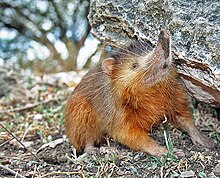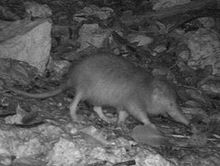Hispaniolan solenodon
| Hispaniolan solenodon[1] | |
|---|---|

| |
| Hispaniolan solenodon | |
| Scientific classification | |
| Kingdom: | |
| Phylum: | |
| Class: | |
| Order: | |
| Family: | |
| Genus: | |
| Species: | S. paradoxus
|
| Binomial name | |
| Solenodon paradoxus Brandt, 1833
| |

| |
| Hispaniolan Solenodon range | |
The Hispaniolan solenodon (Solenodon paradoxus), also known as the Haitian solenodon or Agouta, is a solenodon found only on Hispaniola, the island shared by Haiti and the Dominican Republic. It was unknown to science until 1833, when it was first described by Brandt. A similar but smaller species, Marcano's solenodon (S. marcanoi), once lived on the island, but became extinct after European colonization. All solenodon species belong to order Soricomorpha and family Solenodontidae.
Description and behaviour
The Hispaniolan solenodon looks much like an oversized shrew. It weighs 0.6–1.0 kg. Head-and-body length is 28–33 cm and the tail is 25 cm. It has brownish-red fur on most of its body, with a paler underside. The tail, legs, snout and eartips are hairless. The forelegs are noticeably more developed than the hind legs, but all have strong claws useful for digging.
The head is very big in relation to its body, with a long rostrum and tiny eyes and ears partially hidden by the body fur. A unique feature is the os proboscis, a bone on the tip of the rostrum that supports the snout cartilage. The dental formula for the species is 3/3, 1/1, 3/3, 3/3 = 40. The second lower incisor has a narrow groove ("Solenodon" derives from the Greek "grooved tooth"), through which flows a venomous saliva secreted by the submaxillary gland, making the solenodon one of only a handful of venomous mammals.
Both sexes are similar. Males have an unexposed penis and the testes are hidden deep within the abdominal cavity. Females have an irregular estrus period that is apparently unrelated to seasonal changes; they may have two litters of one to three young per year. Usually only two of the offspring survive, because the female only has two teats, which are found near her buttocks. The young are weaned after 75 days, but may sometimes remain with the parents while subsequent litters are born and raised, so that up to eight animals may share the same burrow. Solenodons may fight each other on first meeting, but eventually they establish a dominance relationship and live together in captivity in relative harmony.
A Hispaniolan solenodon has glands in the armpits and in the groin, which are said to give off a goat-like smell. It readily defends itself against one of its own kind and is apparently not immune to its own venom, since animals have been seen to die after fighting and sustaining minor wounds. It may also attack other animals savagely: a captive solenodon was reported to have attacked a young chicken and torn it to pieces with its strong claws before eating it. In moments of excitement it may grunt like a pig or give bird-like cries, but when pursued it stays motionless and hides its head, making it easy to capture.
One reason why the Hispaniolan solenodon was unknown to science for so long is that it is nocturnal, a consequence of which is its highly developed senses of hearing, smell and touch. Also, they are not very numerous, so their influence in an ecosystem is practically nothing. During daylight hours they stay in their burrows, trees, hollowed-out logs or caves, remaining hidden from view. When they do come out, they run on their toes with a stiff ungainly waddle, following an erratic, almost zigzag course. The local people claim that solenodons never run in a straight line. When a solenodon is alarmed and tries to move faster, it is very likely to trip.
Hispaniolan solenodons eat a wide variety of animals, including arthropods, worms, snails and small reptiles; they may also feed on roots, fruits and foliage, although a study found that they refused all forms of vegetation. They probe the earth with their snout and dig or rip open rotten logs with their claws. Solenodons in captivity have been seen to bathe often and to drink only when bathing.
Ecology

Because of a lack of natural enemies, the Hispaniolan solenodon did not evolve defenses against predators and it is a slow, clumsy runner. When feral dog and cat populations started to become established and Small Asian mongooses (specifically subspecies Herpestes javanicus auropunctatus) were introduced to control rats in sugar cane fields, its future was jeopardized.
The Hispaniolan solenodon's habitat is usually wooded or brushy areas, frequently close to developed agricultural land, where they can dig their complex underground burrows. Habitat loss and predation by introduced species have contributed to making it an endangered species, whose numbers have dropped dramatically during the last decades. It was actually considered almost extinct until 1907, when it was found living in the interior of Hispaniola. It was not considered to be in immediate danger early in the twentieth century. In 1966 it was found in several localities in the Dominican Republic. As of 1981, after extensive searching, it was concluded that the Hispaniolan solenodon was "functionally extinct"[clarification needed] in Haiti, persisting only in the remote mountains of the south. In 1987 it was still found in both countries, but was thought to be particularly threatened in Haiti. As of 1996, it could still be found in both countries. Wildlife filmmaker Jürgen Hoppe has been able to film the Hispaniolan solenodon in various parts of the Dominican Republic during the last 18 years.[as of?] The most recent sightings in the wild (with video evidence) were during the summer of 2008, when a team of researchers from the Durrell Wildlife Conservation Trust and the Ornithological Society of Hispaniola were able to trap an individual specimen. The researchers took physical measurements and DNA from it before releasing it back into the wild.[3]
The Hispaniolan solenodon appears to have a patchy distribution. Populations are found both within and outside protected areas such as the Jaragua, Del Este and Sierra de Baoruco National Parks. In Haiti it is reported from La Visite National Park and the Duchity region of the Massif de la Hotte.[4] Its presence in Los Haitises National Park in the Dominican Republic is inferred but unconfirmed.
Conservation
The Hispaniolan solenodon was identified as one of the top ten "focal species" in 2007 by the Evolutionarily Distinct and Globally Endangered (EDGE) project.[5] A collaborative conservation project funded by the Darwin Initiative (UK) was started in 2009 and is researching the species in order to conserve it.[6]
The species is fully protected by law. However, national parks in both the Dominican Republic and Haiti are threatened by deforestation and encroachment for farming and charcoal production. The US Agency for International Development and the Nature Conservancy are[as of?] working with local non-governmental organisations to improve protection and implement management plans for these parks (the "Parks in Peril" programme). A recovery plan for the isolated Haitian population published in 1992 advocated comprehensive surveys, improved management of the Pic Macaya National Park, education campaigns, control of exotic mammals, and an ex situ breeding programme. These recommendations have not yet[as of?] been implemented.
Two conservation research and education programmes funded by the Darwin Initiative have recently been established, focusing on solenodons in both the Dominican Republic and Haiti: "Building evidence and capacity to conserve Hispaniola's endemic land mammals" (started 2009), and "Building a future for Haiti's unique vertebrates" (started 2010). These collaborative projects represent a partnership between the EDGE programme, the Durrell Wildlife Conservation Trust, BirdLife International, the Sociedad Ornitologica de la Hispaniola, the Dominican Republic National Zoo, Societe Audubon Haiti, and in-country project partners.
See also
References
- ^ Hutterer, R. (2005). "Order Soricomorpha". In Wilson, D.E.; Reeder, D.M (eds.). Mammal Species of the World: A Taxonomic and Geographic Reference (3rd ed.). Johns Hopkins University Press. p. 223. ISBN 978-0-8018-8221-0. OCLC 62265494.
- ^ Template:IUCN2011.1
- ^ "Venomous mammal caught on camera". BBC. 2009-01-09. Retrieved 2009-01-09.
- ^ Samuel T. Turvey, Helen M.R. Meredith and R. Paul Scofield (2008). Continued survival of Hispaniolan solenodon Solenodon paradoxus in Haiti. Oryx, 42 , pp 611-614. doi:10.1017/S0030605308001324
- ^ "Protection for 'weirdest' species". BBC. 2007-01-16. Retrieved 2007-05-22.
- ^ "The Last Survivors project".
- Solenodon Paradoxus, by Adam Eatroff
- Solenodon, from the International Wildlife Encyclopedia
- Haitian Solenodon, by Paul Massicot
- Solenodons, from Walker's Mammals of the World Online
External links
- EDGE of Existence "(Hispaniolan solenodon)" Saving the World's most Evolutionarily Distinct and Globally Endangered (EDGE) species
- the last survivors conservation project
- Eladio M. Fernández - Caribbean Nature Photography
- Picture of S. paradoxus Best photo available on the web.
- Animal Info - Haitian Solenodon
- Film of Hispaniolan Solenodon
- BBC article with video

